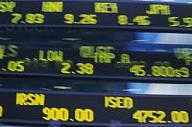
 |
|
| Financial Terms | |
| Working capital ratio |
|
Information about financial, finance, business, accounting, payroll, inventory, investment, money, inventory control, stock trading, financial advisor, tax advisor, credit.
Main Page: tax advisor, payroll, finance, financial, investment, inventory, accounting, money, Also see related: buy home, credit, home insurance, property, mortgage, condo, home, first time homebuyer, financing, |
Definition of Working capital ratio
Working capital ratioworking capital expressed as a percentage of sales.
Related Terms:Acid-test ratioAlso called the quick ratio, the ratio of current assets minus inventories, accruals, and prepaid Appraisal ratioThe signal-to-noise ratio of an analyst's forecasts. The ratio of alpha to residual standard Articles of incorporationLegal document establishing a corporation and its structure and purpose. Asset/equity ratioThe ratio of total assets to stockholder equity. Asset activity ratiosratios that measure how effectively the firm is managing its assets. Average cost of capitalA firm's required payout to the bondholders and to the stockholders expressed as a CapitalMoney invested in a firm.  Capital accountNet result of public and private international investment and lending activities. Capital allocationdecision Allocation of invested funds between risk-free assets versus the risky portfolio. Capital asset pricing model (CAPM)An economic theory that describes the relationship between risk and Capital budgetA firm's set of planned capital expenditures. Capital budgetingThe process of choosing the firm's long-term capital assets. Capital expendituresAmount used during a particular period to acquire or improve long-term assets such as Capital flightThe transfer of capital abroad in response to fears of political risk. Capital gainWhen a stock is sold for a profit, it's the difference between the net sales price of securities and Capital gains yieldThe price change portion of a stock's return.  Capital leaseA lease obligation that has to be capitalized on the balance sheet. Capital lossThe difference between the net cost of a security and the net sale price, if that security is sold at a loss. Capital marketThe market for trading long-term debt instruments (those that mature in more than one year). Capital market efficiencyReflects the relative amount of wealth wasted in making transactions. An efficient Capital market imperfections viewThe view that issuing debt is generally valuable but that the firm's Capital market line (CML)The line defined by every combination of the risk-free asset and the market portfolio. Capital rationingPlacing one or more limits on the amount of new investment undertaken by a firm, either Capital structureThe makeup of the liabilities and stockholders' equity side of the balance sheet, especially Capital surplusAmounts of directly contributed equity capital in excess of the par value. CapitalizationThe debt and/or equity mix that fund a firm's assets. Capitalization methodA method of constructing a replicating portfolio in which the manager purchases a Capitalization ratiosAlso called financial leverage ratios, these ratios compare debt to total capitalization Capitalization tableA table showing the capitalization of a firm, which typically includes the amount of CapitalizedRecorded in asset accounts and then depreciated or amortized, as is appropriate for expenditures Capitalized interestInterest that is not immediately expensed, but rather is considered as an asset and is then Cash flow coverage ratioThe number of times that financial obligations (for interest, principal payments, Cash flow from operationsA firm's net cash inflow resulting directly from its regular operations Cash ratioThe proportion of a firm's assets held as cash. Common stock ratiosratios that are designed to measure the relative claims of stockholders to earnings Complete capital marketA market in which there is a distinct marketable security for each and every Concentration accountA single centralized account into which funds collected at regional locations Concentration servicesMovement of cash from different lockbox locations into a single concentration Controlled foreign corporation (CFC)A foreign corporation whose voting stock is more than 50% owned Conversion ratioThe number of shares of common stock that the security holder will receive from CorporationA legal "person" that is separate and distinct from its owners. A corporation is allowed to own Cost of capitalThe required return for a capital budgeting project. Cost of limited partner capitalThe discount rate that equates the after-tax inflows with outflows for capital Cost-benefit ratioThe net present value of an investment divided by the investment's initial cost. Also called Coverage ratiosratios used to test the adequacy of cash flows generated through earnings for purposes of Current ratioIndicator of short-term debt paying ability. Determined by dividing current assets by current Customary payout ratiosA range of payout ratios that is typical based on an analysis of comparable firms. Days' sales in inventory ratioThe average number of days' worth of sales that is held in inventory. Debt/equity ratioIndicator of financial leverage. Compares assets provided by creditors to assets provided Debt ratioTotal debt divided by total assets. Debt-service coverage ratioEarnings before interest and income taxes plus one-third rental charges, divided Declaration dateThe date on which a firm's directors meet and announce the date and amount of the next Dedicated capitalTotal par value (number of shares issued, multiplied by the par value of each share). Also Dividend payout ratioPercentage of earnings paid out as dividends. Dollar durationThe product of modified duration and the initial price. Domestic International Sales Corporation (DISC)A U.S. corporation that receives a tax incentive for DurationA common gauge of the price sensitivity of an asset or portfolio to a change in interest rates. Earnings retention ratioPlowback rate. Edge corporationsSpecialized banking institutions, authorized and chartered by the Federal Reserve Board Effective durationThe duration calculated using the approximate duration formula for a bond with an Efficient capital marketA market in which new information is very quickly reflected accurately in share Expense ratioThe percentage of the assets that were spent to run a mutual fund (as of the last annual ExpirationThe time when the option contract ceases to exist (expires). Expiration cycleAn expiration cycle relates to the dates on which options on a particular security expire. A Expiration dateThe last day (in the case of American-style) or the only day (in the case of European-style) Feasible target payout ratiosPayout ratios that are consistent with the availability of excess funds to make Federal Deposit Insurance Corporation (FDIC)A federal institution that insures bank deposits. Financial leverage ratiosRelated: capitalization ratios. Financial ratioThe result of dividing one financial statement item by another. ratios help analysts interpret Fisher's separation theoremThe firm's choice of investments is separate from its owner's attitudes towards Fixed asset turnover ratioThe ratio of sales to fixed assets. Fixed-charge coverage ratioA measure of a firm's ability to meet its fixed-charge obligations: the ratio of Foreign Sales Corporation (FSC)A special type of corporation created by the Tax Reform Act of 1984 that Freddie Mac (Federal Home Loan Mortgage Corporation)A Congressionally chartered corporation that Funding ratioThe ratio of a pension plan's assets to its liabilities. Funds From Operations (FFO)Used by real estate and other investment trusts to define the cash flow from Hard capital rationingcapital rationing that under no circumstances can be violated. Hedge ratio (delta)The ratio of volatility of the portfolio to be hedged and the return of the volatility of the Human capitalThe unique capabilities and expertise of individuals. Income statement (statement of operations)A statement showing the revenues, expenses, and income (the Interest coverage ratioThe ratio of the earnings before interest and taxes to the annual interest expense. This Irrational call optionThe implied call imbedded in the MBS. Identified as irrational because the call is Issued share capitalTotal amount of shares that are in issue. Related: outstanding shares. Legal capitalValue at which a company's shares are recorded in its books. Leverage ratiosMeasures of the relative contribution of stockholders and creditors, and of the firm's ability Liquidity ratiosratios that measure a firm's ability to meet its short-term financial obligations on time. Long-term debt/capitalizationIndicator of financial leverage. Shows long-term debt as a proportion of the Long-term debt ratioThe ratio of long-term debt to total capitalization. Long-term debt to equity ratioA capitalization ratio comparing long-term debt to shareholders' equity. Low price-earnings ratio effectThe tendency of portfolios of stocks with a low price-earnings ratio to Liquidity ratiosratios that measure a firm's ability to meet its short-term financial obligations on time. Macaulay durationThe weighted-average term to maturity of the cash flows from the bond, where the Market capitalizationThe total dollar value of all outstanding shares. Computed as shares times current Market capitalization rateExpected return on a security. The market-consensus estimate of the appropriate Market value ratiosratios that relate the market price of the firm's common stock to selected financial Market-book ratioMarket price of a share divided by book value per share. Modified durationThe ratio of Macaulay duration to (1 + y), where y = the bond yield. Modified duration is Mortgage durationA modification of standard duration to account for the impact on duration of MBSs of Mortgage-Backed Securities Clearing CorporationA wholly owned subsidiary of the Midwest Stock Related to : financial, finance, business, accounting, payroll, inventory, investment, money, inventory control, stock trading, financial advisor, tax advisor, credit. |